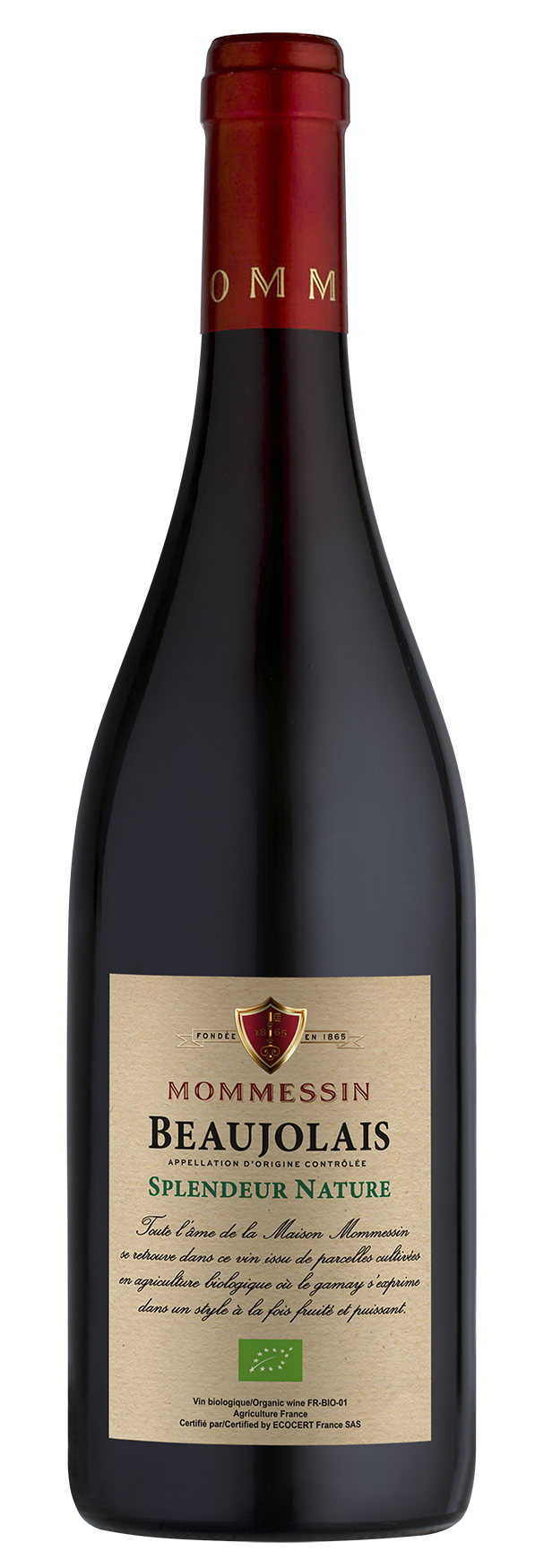BEAUJOLAIS BIO 2021
Grape varietal
100% Gamay.
Tasting notes
Colour: Beautiful, intense ruby colour.
Nose: The bouquet is equally intense, offering subtle, varied aromas of red fruit.
Palate: A fine, elegant wine that reveals a wide range of crisp fruit flavours and tremendous freshness.
Serving suggestions
Serve at a temperature of 13-14°C. (55-57°F).
Food and wine pairing
May be enjoyed simply as an aperitif, accompanied by a selection of local charcuterie or a home-made country terrine, or during a meal, accompanied by white meat, grilled food, vegetarian cuisine, savoury tarts, pasta dishes or a lightly seasoned pizza. It also goes very well with mature cheeses.
Ageing potential
Already very pleasant, this Beaujolais can easily be cellared for up to five years.
Origins
The Beaujolais appellation essentially groups together wines from the region located south of Villefranche-sur-Saône. The vineyards vary enormously, extending over 9,700 hectares overlooking the Saône plain between Mâcon and Lyon and bordered to the west by the foothills of the Massif Central.
Terroir
Our wine is made from organically grown Gamay grapes from three different plots.
Two of these consist of mainly hard limestone soil and marl slopes covered with scree with some rows of vines planted on residual clay with pieces of chert.
The vines on the third plot are planted mainly on granite with some on siliceous volcanic rock and on schist or bluish rock.
Vine and soil
- Planting density: 8,000-10,000 vines/ha
- Average age of the vines: 45 years old.
- Yield: 30hl/ha.
- Pruning: Cordon or Single Guyot.
- Vineyard management: organic agriculture.
Everything is carefully analysed: the threat of diseases, the numbers of insect pests and auxiliaries present in the plots’ agro-system, the size and number of bunches, the effect of weeds, the state of the vines’ foliage, etc.
Soil management: decavaillonnage (turning over the soil around the base of each vine), light ploughing, work between the vines.
This approach meets two objectives:
- restoring the physiological balance of the vines, the soil and the terroir,
- protection and respect of the environment.
Vinification and maturing
The harvest in the south of Beaujolais began on 26 September in relatively cool temperatures. This makes 2021 the fourth latest vintage since 1992.
The 2021 harvest was characterized by significant differences between plots, due to the great diversity of the terroirs, with varying sensitivity to the vagaries of the weather over the course of the year, which ultimately resulted in variable yields (from normal to very low). Sorting was carried out in the vineyard and in the winery. The wines are lighter in alcohol and structure.
Most of the grapes were 100% destemmed and macerated for 8-10 days. There are also wines produced in the traditional Beaujolais style in the blend, with semi-carbonic maceration from 5 to 8 days. This wine was aged on fine lees in stainless steel and concrete vats.
Vintage : 2021
The first quarter of 2021 was characterized by moderate temperatures and a slight surplus of rainfall. These conditions led to a bud break around 5 April.
April was marked by a historic period of frost between 5 and 8 April. May was also particularly cold and very rainy but quite sunny.
As a result of these two cool months, flowering started late (9 June on average). July was cool, not very sunny and very rainy. It had not rained so much in July for 44 years.
August was generally cool and dry. Ripening (véraison) began around 5 August. At this stage, the 2021 vintage was 18 days behind the 2020 vintage.
The weather conditions gave us no respite, generating considerable extra work in the vineyard. Fortunately, the weather became mild after 12 August and remained so until the harvest.




